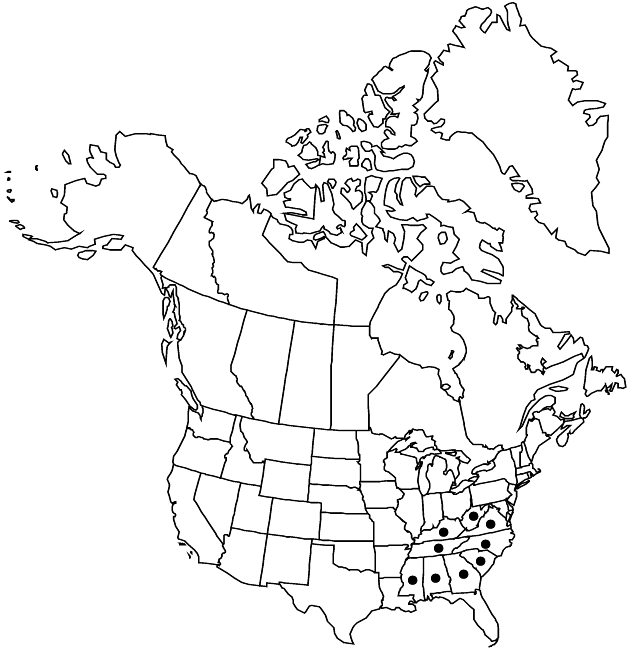Difference between revisions of "Solidago curtisii"
Fl. N. Amer. 2: 200. 1842.
FNA>Volume Importer |
RevisionBot (talk | contribs) m (Bot: Adding category Revised Since Print) |
||
| (4 intermediate revisions by 3 users not shown) | |||
| Line 8: | Line 8: | ||
}} | }} | ||
|common_names=Curtis’ goldenrod | |common_names=Curtis’ goldenrod | ||
| + | |special_status={{Treatment/ID/Special_status | ||
| + | |code=E | ||
| + | |label=Endemic | ||
| + | }} | ||
|basionyms= | |basionyms= | ||
|synonyms={{Treatment/ID/Synonym | |synonyms={{Treatment/ID/Synonym | ||
| Line 28: | Line 32: | ||
-->{{Treatment/Body | -->{{Treatment/Body | ||
| − | |distribution= | + | |distribution=Ala.;Ga.;Ky.;Miss.;N.C.;S.C.;Tenn.;Va.;W.Va. |
|discussion=<p>Varieties 2 (2 in the flora).</p><!-- | |discussion=<p>Varieties 2 (2 in the flora).</p><!-- | ||
--><p><i>Solidago curtisii</i> is similar to <i>S. caesia</i> and may be confused with robust, pressed and dried specimens of the latter if they are mounted such that the arching habit cannot be observed.</p> | --><p><i>Solidago curtisii</i> is similar to <i>S. caesia</i> and may be confused with robust, pressed and dried specimens of the latter if they are mounted such that the arching habit cannot be observed.</p> | ||
| Line 59: | Line 63: | ||
|basionyms= | |basionyms= | ||
|family=Asteraceae | |family=Asteraceae | ||
| − | |distribution= | + | |distribution=Ala.;Ga.;Ky.;Miss.;N.C.;S.C.;Tenn.;Va.;W.Va. |
|reference=None | |reference=None | ||
|publication title=Fl. N. Amer. | |publication title=Fl. N. Amer. | ||
|publication year=1842 | |publication year=1842 | ||
| − | |special status= | + | |special status=Endemic |
| − | |source xml=https:// | + | |source xml=https://bitbucket.org/aafc-mbb/fna-data-curation/src/2e0870ddd59836b60bcf96646a41e87ea5a5943a/coarse_grained_fna_xml/V19-20-21/V20_255.xml |
|tribe=Asteraceae tribe Astereae | |tribe=Asteraceae tribe Astereae | ||
|genus=Solidago | |genus=Solidago | ||
| Line 72: | Line 76: | ||
}}<!-- | }}<!-- | ||
| − | -->[[Category:Treatment]][[Category:Solidago subsect. Glomeruliflorae]] | + | --> |
| + | |||
| + | [[Category:Treatment]] | ||
| + | [[Category:Solidago subsect. Glomeruliflorae]] | ||
| + | [[Category:Revised Since Print]] | ||
Latest revision as of 18:21, 6 November 2020
Plants (20–)40–90(–100) cm; caudices woody. Stems 1–4, erect, straight, glabrous or moderately hirtello-strigose. Leaves: basal withering by flowering; proximal to mid cauline weakly petiolate or sessile, blades lanceolate to elliptic, (36–)95–150(–180) × (10–)19–43(–60) mm, margins serrate (with (3–)8–20(–36) teeth), faces glabrous or sparsely hairy, more so along nerves; distal cauline sessile, blades narrowly lanceolate to narrowly elliptic, (5–)37–90(–130) × (3.5)5–18(–34) mm, margins entire to sparsely serrate (0–9(–14) teeth), faces glabrous or sparsely hairy, sometimes more pilose along nerves. Heads 20–800 in short axillary and terminal racemiform/paniculiform, non-secund arrays (2–)8.5–38.5(–65) cm. Peduncles 2–6 mm, moderately to densely finely strigose; bracteoles 0–3, linear-oblong. Involucres narrowly campanulate, (5–)5.6–7(–8) mm. Phyllaries in 3–4 series, strongly unequal, outermost 1–1.4(–2) mm, innermost (2.5–)3–4(–4.4) mm, obtuse to acute, 1-nerved. Ray florets 2–4(–6); laminae (2–)2.5–4(–4.6) × 1–2 mm. Disc florets 3–7(–9); corollas mostly 2–3 mm, lobes 1–1.7(–2.4) mm. Cypselae 1–2(–3) mm, sparsely to moderately strigose; pappi (2–)2.7–3.6(–4.5) mm.
Distribution

Ala., Ga., Ky., Miss., N.C., S.C., Tenn., Va., W.Va.
Discussion
Varieties 2 (2 in the flora).
Solidago curtisii is similar to S. caesia and may be confused with robust, pressed and dried specimens of the latter if they are mounted such that the arching habit cannot be observed.
Selected References
None.
Key
| 1 | Proximal midcauline leaf blades broadly lanceolateand sparsely hairy | Solidago curtisii var. curtisii |
| 1 | Proximal midcauline leaf blades elliptic and moderately hairy 22b. Solidago curtisii var. flaccidifolia | > 1 |